What are musical modes and how to use them?
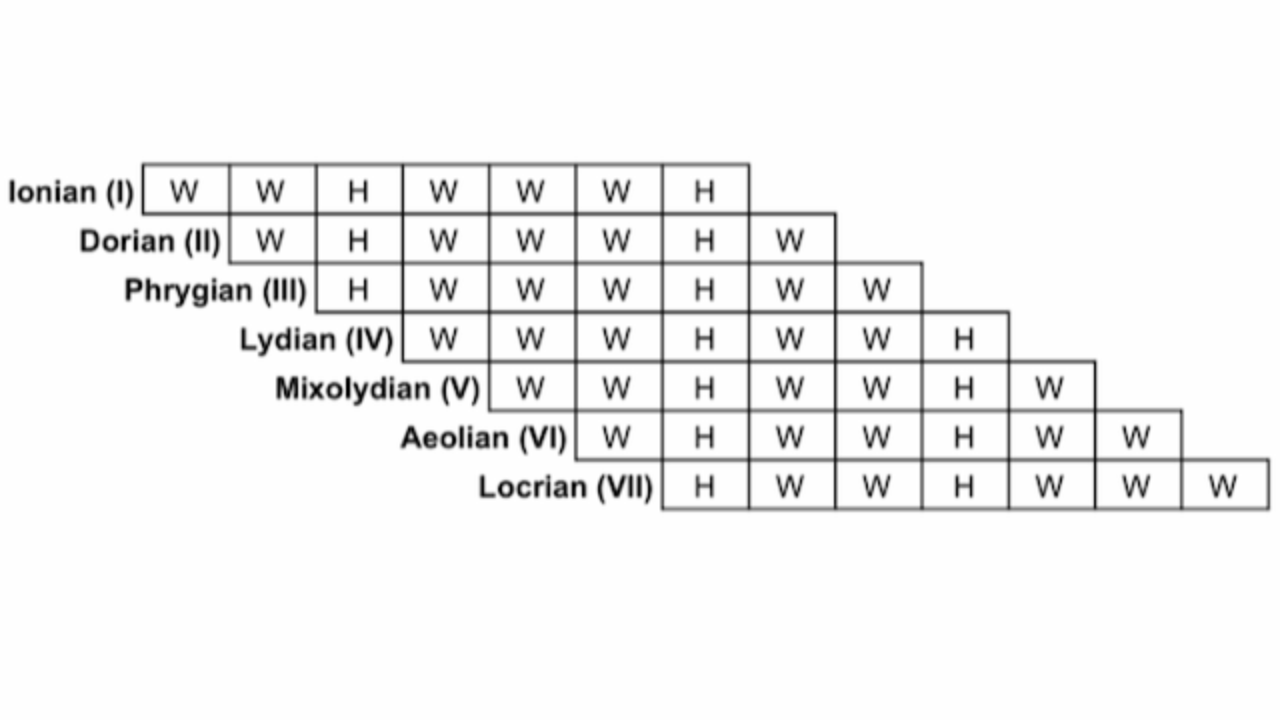
Musical modes have been around for a very long time, with their names dating back to ancient Greece, but understanding how to use modes is as relevant now as it’s ever been.
From classic composition right through to jazz and modern progressive music, modes are an essential piece of theory that all musicians should be familiar with.
But remember, becoming familiar with something musical should not only be about the study of shapes and patterns. We must learn to internalize the new sounds we’re hearing too – this is too often overlooked when studying theory.
Today we’re going to help you with understanding musical modes, how to use them effectively, and perhaps most importantly – how to start recognizing them by ear!
What are musical modes?
There are seven commonly used types of musical modes, each based on the diatonic scale. They all have their own unique sound and can be used to express different moods and emotions.
Two of these modes you are probably quite familiar with: major (aka ionian) and minor (aka aeolian). We know one of these scales feels ‘happier’ than the other, right? This is a basic example of how modes open up more choices for us to express emotions musically.
The feeling of a mode depends on the structure of the scale within it, the sequence of those notes, and how they each relate to the tonic.
What are the differences between scales and modes?
When explaining musical modes it should always be within the context of a parent scale – for example, every mode in this article stems from the major scale. So looking at them as independent from each other is the wrong way to go.
Modes are a way of helping make sense of melodies and harmonies that emphasize scale degrees that are not the tonic note of the major or minor key.
The seven different diatonic modes
We build the diatonic scale using a sequence of Tones (whole steps) and Semitones (half steps) this sequence is:
[T - T - S - T - T - T - S]
As you can see, a diatonic scale takes seven steps, for each step we have a scale degree, and for each degree, a corresponding mode.
Let’s look at the C Major scale as an example:

As you can see from the diagram, each mode has a related quality. So let’s split up the different musical modes into two groups – major and minor.
Major Modes
Ionian mode (I)
The first in our list of musical modes, often referred to as the major scale – this one sets the standard [1 2 3 4 5 6 7] to which all other modes are compared.
Every mode except ionian will deviate from this sequence in some way – meaning at least one degree will be sharp [♯] or flat [♭].
These deviations will be highlighted in blue on the piano diagrams below.
- Quality*: Happy, uplifting
- Common uses*: Widely used in many western music genres
* Note: The quality and uses of each mode can vary greatly depending on the musical context - these are just a general guide*
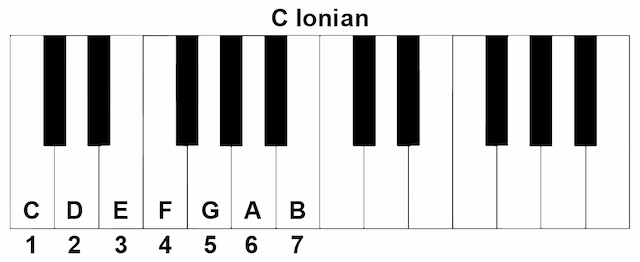
Lydian mode (IV)
[1, 2, 3, #4, 5, 6, 7]
Lydian is the fourth mode, identical to major apart from the [♯4] which creates a distinctive tritone interval with the tonic, the tritone is one of the more dissonant intervals.
- Quality: Magical, dreamy
- Common uses: Film scores, progressive music
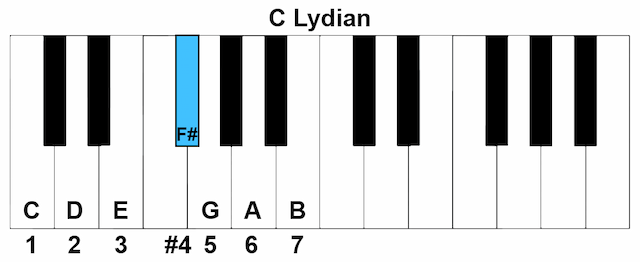
Mixolydian mode (V)
[1, 2, 3, 4, 5, 6, b7]
The fifth mode and the last of our major modes. Again, similar to the major scale apart from one change – the [♭7].
- Quality: Like a moody major scale, slightly bluesy
- Common uses: Rock, blues, funk

Minor modes
Aeolian mode (VI)
[1, 2, b3, 4, 5, b6, b7]
Often referred to as the ‘natural minor’ or simply ‘minor’ scale.
We’ve chosen to demonstrate this mode with ‘A’ as the tonic for an important reason – the term ‘relative minor’ stems from the relationship between ionian (major) and aeolian (minor).
As you can see, A minor and C major contain all the same notes (C, D, E, F, G, A, B).
‘A’ is the 6th degree of C major, and aeolian is the 6th (VI) mode.
- Quality: Sad, melancholic
- Common uses: Used widely in all genres of western music.
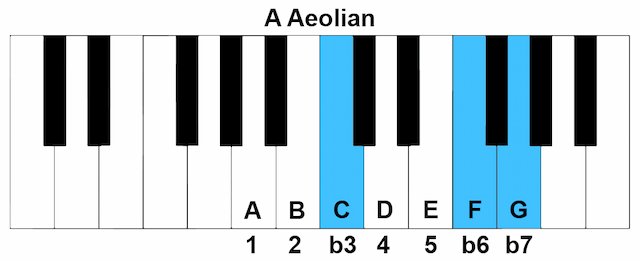
Dorian mode (II)
[1, 2, b3, 4, 5, 6, b7]
Dorian is our second mode and it includes two flat scale degrees compared to the major mode [♭3] & [♭7].
- Quality: Not as dark as aeolian, slightly exotic
- Common uses: Rock, folk, jazz
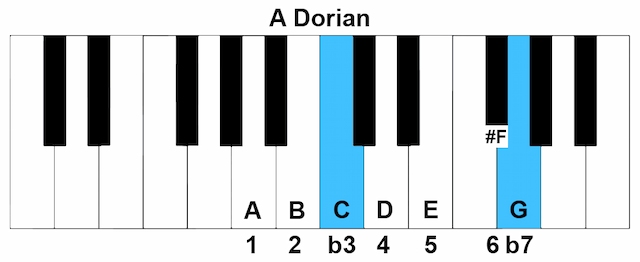
Phrygian mode (III)
[1, b2, b3, 4, 5, b6, b7]
Besides the perfect intervals (1, 4, 5) every note in the phrygian mode has been flattened [♭2] [♭3] [♭6] [♭7].
- Quality: Mysterious, very exotic
- Common uses: Metal, flamenco, world
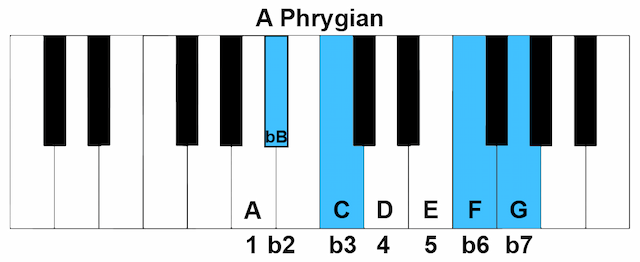
Locrian mode (VII)
[1, b2, b3, 4, b5, b6, b7]
Locrian contains the most amount of flattened scale degrees of any mode and like lydian, contains the tritone.
- Quality: Unsettling, dissonant
- Common uses: Rarely heard in western music. Perhaps found in obscure jazz or metal.
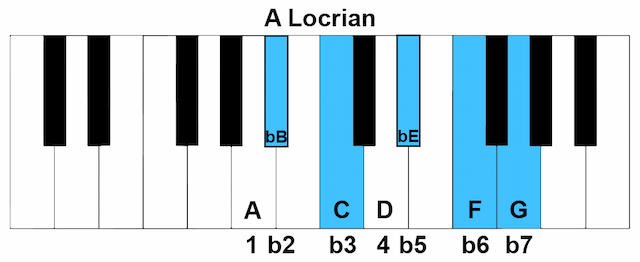
How to build modes?
As we’ve already shown, modes are always built from a parent scale. Once you have the structure for that scale, you can build any mode from any root note.
In our case, the parent scale is major (ionian) and the sequence is [T-T-S-T-T-T-S]
In the diagram below, we have a list of the musical modes names and their corresponding patterns. The sequence remains the same for each mode – we just start the pattern from a different place.
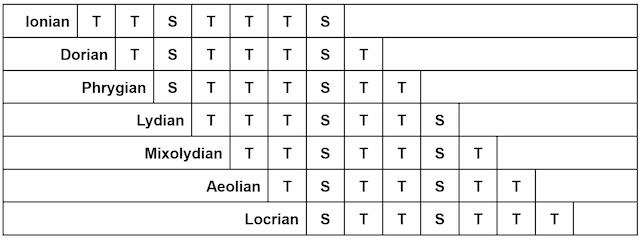
You can simply take one of these patterns, apply it from a root note and that will be your mode.
Let’s try one together:
- Decide what mode we want to play – let’s say, phrygian.
- Next we have to choose what note we want our mode to start on – how about D?
- Now just follow our phrygian sequence
[S-T-T-T-S-T-T]starting from D. D > [S] = Eb > [T] = F > [T] = G > [T] = A > [S] = Bb > [T] = C > [T] = D(back where we started!)- So our notes to build the D Phrygian mode are – D, Eb, F, G, A, Bb, C
The diagram above should help you visualize the patterns and work as a tool for building any mode for whatever key you want to play in.
How to use musical modes in your music?
As we’ve just seen, every mode has a unique sound and mood. Make yourself familiar with each one and begin to integrate certain elements into your writing/playing.
It doesn’t need to be all or nothing. Just take a scale you already know and incorporate one note from another mode. Guitar players often do this – for example, adding a major 6th to the commonly used minor pentatonic scale to give it a dorian flavor.
In certain instances, it might work really well – in others, not so much.
It all depends on the harmonic structure of the piece (the chord progression, the other melodic lines, etc.)
Your ear should be able to tell you when it sounds good and when not.
The trick with most things in music is to experiment and keep your ears switched on – if you’re not listening, you’re not learning. Spend time getting to know what elements of each mode you like, and try to see how you can utilize them over different chord progressions.
Why should you learn music modes?
You may be saying to yourself, “if 90% of the music I hear is in major or minor, then why do I need to know musical modes?”
Modes simply give you more options, and are a great way to create unique harmonies and melodies in your music. Why wouldn’t you want to have a bigger palette of colors to choose from?
That being said, it’s vital to first distinguish and master those two most commonly used modes – ionian (major) and aeolian (minor).
These should work as your foundation and gateway to the other modes.
Not only are they by far the most popular modes in western music, but mastering them will give you a deep sense of the differences in quality between major and minor modes, scales, and chords.
Once you’re comfortable with those two, slowly move on to other modes – one at a time! Trying to learn them all at once will just end in confusion. The nuances of each mode need to be internalized.
A step-by-step ear training method to develop your musicality – from zero to using modes intuitively
If you want to check out a reliable, science-based, step-by-step method for ear training, take a look at our Free Use Your Ear Workshop. It’s entirely free and provides a great breakdown of our approach, along with valuable tips for maximizing your ear training. You’ll learn the fundamental techniques to get you on the right ear-training path depending on your current level, and we’ll show you how to avoid picking up bad habits.
There are no obligations, just expert advice and some free ear training exercises to try out.
To really get the ball rolling we recommend our relative pitch video course. This is where our method truly shines. Many musicians have gone from being tone-deaf to having an extremely refined musical ear. You'll develop an intuitive ability to identify melody and harmony, be able to rapidly translate notation into real music, and apply your new skills to any musical situation.
We’ve based our course on the most serious scientific research, created innovative exercises, and tested our program extensively with thousands of music students. The results have been incredible, listen for yourself.
We know some prefer talking to a real tutor, for those people we offer private lessons with instructors who are experts in the Use Your Ear method. They will provide unique lessons tailored to you, offering instant feedback in a one-on-one setting.
We can’t wait to help you get to that next level in your musical journey!
Conclusion
Hopefully, you have a much better idea of how to understand, build, and use modes in your music.
Just remember not to fall into the trap of making modes and scales only about visual patterns that you drill mindlessly. Above all, they are sounds, and music should always be about what you hear and feel.
Being able to play and respond to music intuitively relies on a great musical ear – the Use Your Ear method will help you develop one!

